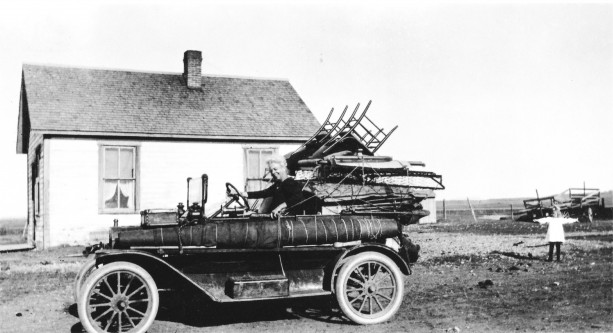Pioneer Dentist in Central Montana
Written by Suzanne Waring

Lottie Conyngham tied furniture onto her car and headed out to furnish the house built on her homestead at Windham. Original photo with the Montana Historical Society Research Center #946-908. Below: Molds used by dentists, like Lottie, in the early 20th Century. This set belonged to Dr. Peter Stukey, who practiced in Great Falls between 1908 and 1961. Courtesy of History Museum.
During the first decade of the twentieth century, you could have counted on your fingers the number of Montana women credentialed as physicians, dentists, or lawyers. The attitude about them is indicated in the instance of Lottie M. Conyngham who was a trained dentist. People and newspapers generally used the title of Mrs. instead of Dr.—or both in reference to her. Regardless of the title, when those living in Central Montana needed a dentist, they gratefully submitted to her gentle touch. Lottie Kidd was born in Leonida, Michigan, on July 9, 1864, and grew up in White Pigeon, Michigan. She was the daughter of a miller who owned the Kidd Flour Mill on the Fawn River. Lottie graduated from White Pigeon High School in 1881. During the graduation ceremony, Lottie shared an essay that she had written on the “Influence of the Scientific Culture.” One can only wonder why she became interested in this topic and how it drove her decisions later in life.
Although it is unknown who or what influenced her to come to the Montana Territory, Lottie received a “first grade” Montana teaching certificate in July 1888. At that time this class of teaching certificate could be earned only after an individual had taught for at least a year and after passing a subjective examination given by the County Superintendent of Schools. In this case, the Gallatin County Superintendent of Schools administered the examination.
Lottie was hired as a teacher for District #18, Timberline School, which was located in what is now Park County on the Bozeman Pass next to a mine that provided coal for the railroad. She taught at Timberline for at least two years. While she was living there, she married George Washington Mardis on September 1, 1890. It is unknown where a divorce or annulment was filed as Mardis moved to Arizona and remarried a few years later.
In Salt Lake City, only seven months after her first marriage, Lottie married a second time on March 30, 1891, to Dr. Edward F. Conyngham. They moved to Phillipsburg, Montana, where he opened his practice. During the ensuing years, a son, Edward Francis, was born. He died at the age of two months.
In the late summer of 1900, Lottie went to Chicago and later her husband joined her. He underwent additional study and practice as a surgeon while Lottie completed a three-month course in dentistry at a dental college. The Phillipsburg Mail reported on December 14, 1900, that “they had returned to town and she had supplied herself with a complete set of the latest improved dental instruments and would embark in the practicing of the profession.”
Soon after, the Conynghams moved to Lewiston, Idaho, where the doctor established his medical practice. Lottie passed the dental examination in Idaho on October 15, 1903, and obtained a license in Montana on June 8, 1904. After close to fifteen years of marriage, the couple divorced in October 1905. In 1906 Lottie moved to Kendall, Montana, a Central Montana town that relied on a gold mine for its existence. She stayed there until after 1909 when the gold played out and people moved away. For a time she was both dentist and postmistress in Kendall.
Because she needed transportation, she bought a car and learned how to drive. Others often joined her, and they would travel quite a long distance to visit friends throughout Central Montana.
During her time in Kendall she homesteaded 120 acres near Windham in Judith Basin County. She called it her ranch. The erection of a house on the property began in October 1909. A May 17, 1910 article in the Lewistown Democrat reported that she assisted in carpentry work on the house. On May 21, 1912, Lottie piled furniture onto her car and headed out to Windham to furnish the ranch house. By May 1913, she had proved up the homestead.
For a number of years after the Kendall mine closed, Lottie was a traveling dentist for the communities of Neihart, Winnifred, and Hilger. She would arrive in one of these communities, see her patients, and then travel on to the next town. Several times she took patients to court when they refused to pay her.
In 1910, she was living in her own home in Maiden, Montana, where she boarded a number of young single people. This is where she may have gotten the nickname, “Mother.” She often chaperoned parties for the young people and held dinners after dances or ballgames for them.
The February 11, 1915 Denton Recorder indicated that, “Mrs. Dr. Conyngham will be in Denton until the eighth day of May, when she will be absent about a couple of months. Mrs. Conyngham will then return and erect a building for the practice of dentistry and will remain permanently in Denton.” After moving to Denton, Lottie homesteaded 200 acres in northern Fergus County. This was proved up in 1920. Next she applied for and received a livestock brand. When she borrowed $9,200 against the Fergus County land and was unable to make the yearly payment several years later, she lost it but so did many others during the drought and recession of the 1920s.
She told friends that she hoped to continue to work the rest of her life, although she had become hearing impaired. It turned out to be just that way. After living in Denton for twenty-two years, at the age of seventy-three, on March 25, 1937, she was struck down by a stroke while she was working on a dental plate for one of her patients and died a few hours later. She had been in poor health for several years.
In announcing her death, the Lewistown Democrat News said, “Dr. Conyngham was possessed of many sterling qualities of character, not to the least of which was her loyalty to her friends. …she was uncomplaining, and her many kindly deeds, generosity, and kindly ways won for her the love and respect of a wide circle of friends who deeply regret her passing.” Interment took place at the Hillcrest Cemetery at the edge of Denton.
